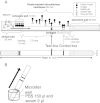Development of an immunochromatography strip test based on truncated nucleocapsid antigens of three representative hantaviruses
- PMID: 24885901
- PMCID: PMC4047433
- DOI: 10.1186/1743-422X-11-87
Development of an immunochromatography strip test based on truncated nucleocapsid antigens of three representative hantaviruses
Abstract
Background: Hantaviruses are causative agents of hemorrhagic fever with renal syndrome (HFRS) and nephropathia epidemica (NE) in the Old World and hantavirus pulmonary syndrome (HPS) in the New World. There is a need for time-saving diagnostic methods. In the present study, recombinant N antigens were used as antigens in an immunochromatography strip (ICG) test to detect specific IgG antibodies.
Methods: The N-terminal 103 amino acids (aa) of Hantaan virus (HTNV), Puumala virus (PUUV) and Andes virus (ANDV) nucleocapsid (N) protein were expressed in E. coli as representative antigens of three groups (HFRS, NE and HPS-causing viruses) of hantavirus. Five different types of ICG test strips, one antigen line on one strip for each of the three selected hantaviruses (HTNV, PUUV and ANDV), three antigen lines on one strip and a mixed antigen line on one strip, were developed and sensitivities were compared.
Results: A total of 87 convalescent-phase patient sera, including sera from 35 HFRS patients, 36 NE patients and 16 HPS patients, and 25 sera from healthy seronegative people as negative controls were used to evaluate the ICG test. Sensitivities of the three-line strip and mixed-line strip were similar to those of the single antigen strip (97.2 to 100%). On the other hand, all of the ICG test strips showed high specificities to healthy donors.
Conclusion: These results indicated that the ICG test with the three representative antigens is an effective serodiagnostic tool for screening and typing of hantavirus infection in humans.
Figures



Similar articles
-
Rapid, whole blood diagnostic test for detecting anti-hantavirus antibody in rats.J Virol Methods. 2013 Oct;193(1):42-9. doi: 10.1016/j.jviromet.2013.04.021. Epub 2013 May 15. J Virol Methods. 2013. PMID: 23684845
-
Specific humoral reaction of hemorrhagic fever with renal syndrome (HFRS) patients in China to recombinant nucleocapsid proteins from European hantaviruses.Eur J Clin Microbiol Infect Dis. 2011 May;30(5):645-51. doi: 10.1007/s10096-010-1134-5. Epub 2011 Jan 8. Eur J Clin Microbiol Infect Dis. 2011. PMID: 21222012
-
Serological diagnosis with recombinant N antigen for hantavirus infection.Virus Res. 2014 Jul 17;187:77-83. doi: 10.1016/j.virusres.2013.12.040. Epub 2014 Jan 31. Virus Res. 2014. PMID: 24487183 Review.
-
Diagnostic rapid tests for acute hantavirus infections: specific tests for Hantaan, Dobrava and Puumala viruses versus a hantavirus combination test.J Virol Methods. 2003 Mar;108(1):117-22. doi: 10.1016/s0166-0934(02)00282-3. J Virol Methods. 2003. PMID: 12565162
-
Hantaviruses: clinical, microbiologic, and epidemiologic aspects.Crit Rev Clin Lab Sci. 1995;32(5-6):469-508. doi: 10.3109/10408369509082592. Crit Rev Clin Lab Sci. 1995. PMID: 8561891 Review.
Cited by
-
Simultaneous serodetection of major rat infectious pathogens by a multiplex immunochromatographic assay.Exp Anim. 2021 May 13;70(2):161-168. doi: 10.1538/expanim.20-0099. Epub 2020 Nov 12. Exp Anim. 2021. PMID: 33177250 Free PMC article.
-
Antigenic properties of N protein of hantavirus.Viruses. 2014 Aug 13;6(8):3097-109. doi: 10.3390/v6083097. Viruses. 2014. PMID: 25123683 Free PMC article. Review.
-
Multiplex Immunochromatographic Assay for Serologic Diagnosis of Major Infectious Diseases in Laboratory Mice.J Am Assoc Lab Anim Sci. 2019 Nov 1;58(6):790-795. doi: 10.30802/AALAS-JAALAS-19-000008. Epub 2019 Sep 13. J Am Assoc Lab Anim Sci. 2019. PMID: 31519225 Free PMC article.
-
Lanka virus, a Mus booduga-borne orthohantavirus infection-associated febrile illness in Sri Lanka.PLoS Negl Trop Dis. 2025 Jun 11;19(6):e0013169. doi: 10.1371/journal.pntd.0013169. eCollection 2025 Jun. PLoS Negl Trop Dis. 2025. PMID: 40498868 Free PMC article.
-
Advances in the Diagnosis of Foot-and-Mouth Disease.Front Vet Sci. 2020 Aug 21;7:477. doi: 10.3389/fvets.2020.00477. eCollection 2020. Front Vet Sci. 2020. PMID: 32974392 Free PMC article. Review.
References
-
- Schmaljohn CS, Hooper JW. In: Field’s virology. 4. Fields BN KD, Howley PM, editor. Vol. 1. Philadelphia: Lippincott-Raven Publishers; 2002. Bunyaviridae: the viruses and their replication; pp. 1581–1601.
-
- Virus Taxonomy: 2012 release. http://www.ictvonline.org/virusTaxonomy.asp.
Publication types
MeSH terms
Substances
LinkOut - more resources
Full Text Sources
Other Literature Sources
Medical

